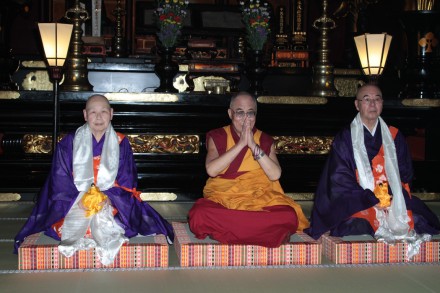
Nagano, Japan: Over 7,000 people filled the Big Hat Stadium with loud applause and cheers as Zenkoji priests gifted His Holiness the Dalai Lama a statue of Gonpo O-pa-me (Amitabha Buddha) at the conclusion of a public talk titled ‘Guide to Positive Clear Light’ Sunday afternoon.
The Gonpo O-pa-me, called Amida in Japanese, is the principal Buddha enshrined and worshipped at the 7th century Zenkoji Temple at Nagano in central Japan. Zenkoji’s most sacred image, The Amida Triad, housed in the main temple, is also the first Buddha image brought to Japan via Korea. The arrival of the image also marked the early propagation of Buddhism in Japan.
This aspect of Zenkoji’s history has a lot of resonance to Jokhang Temple in Tibet’s capital, Lhasa, where the arrival of Buddha Shakyamuni’s image marked the arrival of Buddhism in Tibet, said His Holiness the Dalai Lama in a message issued at the event.
Clear Light, His Holiness explained, reflects the basic nature of the mind which is neutral and is closer to positive emotions such as love, kindness and compassion. Negative emotions like stress, anxiety and selfishness cloud the clear nature of the mind crippling its ability to think and analyze without bias and anger. When we develop a calm mind, we find self-confidence and intelligence to see problems in a holistic manner so we could avoid unrealistic and destructive actions. Understanding the concept of interdependence – that all problems have causes traceable to actions based on ignorance and self-centeredness – is therefore important in developing a holistic view of all existence.
Lack of holistic view, he said, was one of the major reasons that triggered the current global economic crisis. It also led to the failure of the Copenhagen Climate Change summit because more emphasis was put on national interests than global interests. He said the well-being of six billion-strong global family is more important than divisions based race, faith and countries which are secondary concerns. “What is important is the oneness of humanity.”
For many who attended the talk, it was their first experience listening to His Holiness‘ teachings. Although some found the initial parts of the teachings too complex to understand, they said they were impressed by His Holiness‘ message to think globally. “It touched me profoundly when he said both he and I belong to the global family; it gave me a new perspective to see things,” said Iwai Takamoto, 34, from Matsumoto in Nagano Prefecture. “I feel like even I can make a difference.”
For Nami Suzuki, a 28-yr-old pharmacist from Nagano, it was His Holiness‘ reference to environmental issues that she found very relevant. “I think he made a very important point when he said environmental issue is a global concern.”
Hiroko Suzuki said he had heard few spiritual teachers encouraging people to learn new languages and go out in the world and help less privileged people. “I’ll probably learn English,” said the 23-year-old who works at a production company in Nagano.
Rev. Syoryu WADA, president of Zenkoji Temple secretariat said Japan has made great progress in material development but spiritual development is lacking. He said in a country confronted with many conflicting issues of economic crisis, social violence and widespread use of illegal drugs, His Holiness’ teachings can have make a huge difference. Japan’s annual suicide figure now exceeds 30,000. “Many now realize that the more you have, emptier your heart becomes.”
In 2008, Zenkoji Temple received a Buddha statue from His Holiness the Dalai Lama.
–Report filed by Tsering Tsomo
